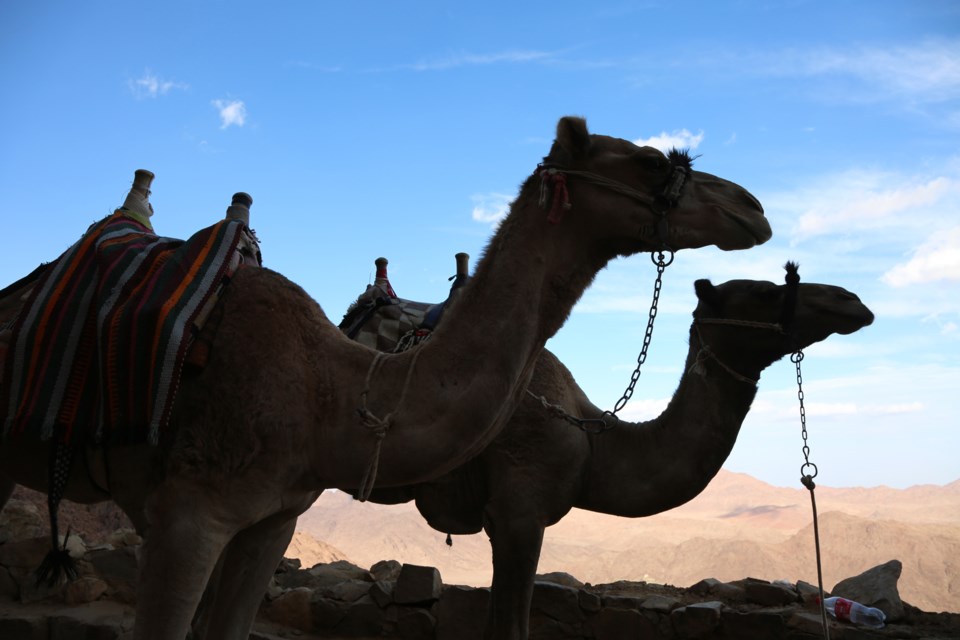SAINT CATHERINE, EGYPT - We stepped off the tour bus into a wave of searing heat. Rocks everywhere, shimmering in the noonday sun. Not a single tree could be seen.
An ancient gate opened into the fortress monastery of St. Catherine. Surprisingly, a few Cypress trees grew in the tiny courtyard. There must be a good well here somewhere, I thought.
We collected room keys and found cool comfort in the small, clean rooms. Foot-thick stone walls and green wooden shutters had effectively barred the desert heat.
For hundreds of years these rooms were home to 1,000 frugal monks. The 26 brothers who still live here grow their own food, pray and copy ancient manuscripts. They guard a treasure trove of precious illuminated manuscripts and priceless icons, intact today because of St. Catherine’s remoteness.
Today, tourists are accommodated in the sparsely furnished rooms at this Greek Orthodox monastery in the heart of the Sinai Desert. Right next to Mount Sinai. The biblical Mount Sinai.
The story of St. Catherine sends chills down my spine. She was a beautiful and intelligent woman from Alexandria.
Why climb Mt. Sinai? To see the place where Moses received the Ten Commandments.
By sunset today, we plan to reach the top of Mount Sinai. We will ride camels for three hours. After that, we will climb 725 steps to the pinnacle of the mountain. If we make it.
I’m already worried about the camel ride and how one stays on top of these beasts. I’ve heard that they spit, too! What if the thing starts galloping into the desert? How would I find my way back to the group?
The smell of camel dung, unwashed bodies and cigarette smoke overpowers the senses as Arabic and English words are shouted to camels and trekkers alike. The confusion of being matched with a camel and a Bedouin clears up and a long caravan forms on the trail. So I won’t be on my own after all. A Bedouin will be right there beside me for the entire ascent.
These Bedouins, or nomads, live in the desert, pasturing their sheep and goats. They own the camels and work as guides for visitors to the monastery.
Muhammad, my Bedouin guide, is dressed in a billowing striped caftan. On his head sits a carelessly twisted turban. His teeth are stained with what looks like rust from too much tea perhaps. He tells me to swing my leg over the wooden two- pronged saddle and I slide into place. It feels snug. The camel lurches forward, then backward and I clutch the front pommel with one hand and the rear one with the other. The rocky ground looks so far below!
Camels have wide hoofs that look like pie plates. They grab onto the trail almost like suction cups as the animal walks in a zigzag pattern along the switchbacked trail.
Muhammad occasionally picks up a lose rock from the trail and sets it aside. Soon the monastery is a dot in the valley below.
After three hours of nervously swaying back and forth, we arrive at a tea house. There are seven of these along the route, small huts draped in saddle blankets. They call this one Starbucks Four.
On foot now, we hike to a viewpoint. Endless granite peaks loom ahead. We turn around to see rocky red steps winding up the mountain. There are 725 of them.
Out of breath and favouring a sore knee, at step 325 I decide to use the help of Suleyman, a Bedouin guide. For US$10, I hang onto his arm and we climb together. Higher up, the air is thin and the sky a deeper blue. Golden light bathes the boulders around us.
One more step and the Bedouin and I stand on top of Mount Sinai. Suleyman’s long, flowing caftan ripples in the breeze. He is as cool as a cucumber. Perspiration blinds my eyes and my damp T-shirt and shorts smell of camel. But, hey, we made it, the Bedouin and I!
The immense canopy of sky above us turns to shades of orange as the sun dips behind Sinai’s peaks. Purple sky gives way to inky black.
Above us, a gazillion stars smear an endless sky. Below us, flashlights light the trail. We’re just a group of Canadian tourists in the Sinai Desert, surrounded by Bedouins, picking our way down God’s mountain. In seven kilometres, we’ll be in the safety of St. Catherine’s monastery. We hope.
Mirjam Rand is an Innisfail-area writer and photographer.

